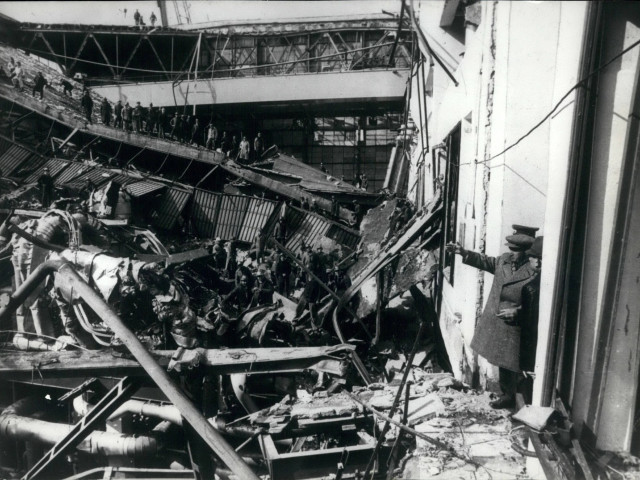Saturday marks 46 years since the earthquake of March 4, 1977, when Romania was shaken by an earthquake with a magnitude of 7.2 degrees on the Richter scale, with the epicenter in the Vrancei Mountains. More than 1,500 people lost their lives then. The previous great earthquake of the 20th century produced in our country took place on November 10, 1940, with a magnitude of 7.4 degrees on the Richter scale, writes Agerpres.
It is 46 years since the 1977 earthquake
The earthquake of March 4, 1977 occurred in Vrancea, at a depth of 100 kilometers, but the shock wave was felt throughout Southeast Europe and reached Russia, Moscow and St. Petersburg. The earthquake occurred at 21:21 on a Friday and lasted 56 seconds.
Among the personalities who lost their lives at that time are the actor Toma Caragiu, the director Alexandru Bocăneț or the singer Doina Badea. After the earthquake, a state of emergency was established on the territory of Romania. More than 30,000 firefighters and soldiers were mobilized for the rescue operations, the largest number of rescuers who ever acted simultaneously in Romania.
More than 1,500 Romanians died in the earthquake of March 4, 1977
The earthquake caused the greatest damage produced by a natural phenomenon in the history of Romania: at the national level, 1,578 people lost their lives (1,424 in Bucharest) and 11,321 people were injured (7,598 in Bucharest). A number of 32 buildings of high or medium height collapsed in the Capital, 32,900 homes were seriously damaged at the national level, approximately 200,000 people were directly affected, according to the mentioned statement.
The strong earthquake of March 4, 1977 caused the collapse or serious damage of hundreds of buildings, under the ruins of which thousands of victims were trapped, as well as the damage of thousands of other residential buildings, hospital units, schools and higher education institutions, kindergartens, nurseries, boarding schools, cultural settlements, historical monuments. The most seriously affected were the city of Bucharest, the southern and eastern regions of the country.
Among the collapsed buildings in Bucharest we mention: the blocks on bd. Magheru and bd. Nicolae Bălcescu, the block on Colonadelor street, the block next to the “Lido” hotel, a building on Ion Ghica street, a block on Ion Brezoianu street, a block on Tudor Arghezi street, a block on Hristo Botev street , a building on Alexandru Sahia street, Moşilor street block no. 135, a building in Galati Street, the block at the intersection of bd. Ştefan cel Mare with Lizeanu street, a block in the Militari district. The new building of the Computing Center belonging to the Ministry of Transport and Telecommunications, near the North Station, also collapsed. Also in Bucharest, the Fundeni Hospital and the Emergency Hospital suffered significant damage and had to be evacuated. At the Emergency Hospital, the shock wave of the earthquake caused damage to one of the resistance structures in a wing of the building, which led to the evacuation of the sick on the night of March 4.
What other big earthquakes have there been in Vrancea, in the last 46 years
An earthquake with a magnitude of 7.1 occurred in Romania on August 31, 1986. Eight people lost their lives as a result of the earthquake, other data reporting a death toll of 150.
The reported seismic intensity was predominantly higher in the direction of Focşani – Iaşi and there were a few victims in the Republic of Moldova (at that time Moldavian SSR, part of the USSR).
Another major earthquake hit Romania on May 30, 1990. The earthquake with a magnitude of 6.9 on the Richter scale occurred at 1:40 p.m. At the level of the entire country, eight deaths were reported as a result of the earthquake, but other data give a balance of 13 deaths.
The highest ground accelerations were measured at the Câmpina, Onești and Bolintin Vale stations. An aftershock measuring 6.4 on the Richter scale was felt on the night of May 31, 14 hours after the stronger earthquake.
The strongest earthquake in Romania was in 1802
Romania is a country with high seismic potential, and an earthquake with a magnitude of 7 degrees is possible at any time. The Vrancea seismic zone is the most active in Romania, but strong earthquakes have occurred in the past, including in the Black Sea.
The strongest earthquake in Romania’s history occurred in 1802, in the Vrancea area, at a depth of 160 kilometers. The earthquake of 1802 was called “The Great Earthquake”. Produced on the day of Saint Parascheva, the tectonic movement affected a large area of the eastern part of Europe, being felt from Moscow and St. Petersburg to Constantinople (Istanbul) and the Island of Ithaca.
How many victims would there be as a result of an earthquake as strong today
According to the 2022 National Disaster Risk Management Plan of the IGSU, it is estimated that there would be over 42,000 dead, 300,000 injured and material losses of over 25 billion euros, in the event of an earthquake of at least 7.4 degrees in Romania.
Specialists say that in the event of such an earthquake there would be great damage to important infrastructures, such as electricity, which will cause blockages immediately after the earthquake. Bucharest would suffer the most, the European capital with the highest risk of disasters and among the first cities in the world in terms of vulnerability to seismic risk. No less than 23,000 buildings in the Capital would suffer huge damage, 1,000 of them to the point of total or partial collapse.
Currently, Bucharest has over 2,400 buildings in classes of seismic risk, of collapsing during an earthquake, most of them located in the center of the Capital. The real number would actually be much higher, because not all buildings have been surveyed.
Editor: Loredana Bancas
Download the Digi24 app and find out the most important news of the day


